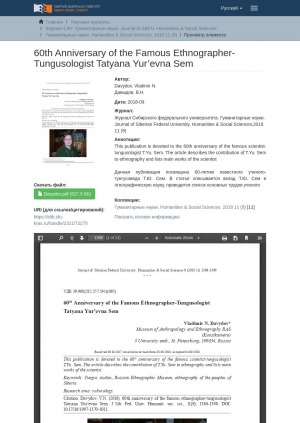- Книга (6113)
- Газета (54)
- Журнал (320)
- Автореферат диссертации (576)
- Изоиздание (51)
- Аудиоиздание (42)
- Видеоиздание (278)
- Картографическое издание (5)
- Неопубликованный документ (611)
- Нотное издание (17)
- Фотография (26)
- Статья (3872)
- Библиографический указатель (91)
- Словарь (12)
- Календарь (7)
- Брошюра (147)
- Буклет (40)
- Электронное издание (2)
- 3D-модель (23)
- Грампластинка (13)
- Веб-архив (2952)
- Бурятский (3)
- Чукотский (9)
- Долганский (2)
- Английский (243)
- Эскимоский (3)
- Эвенкийский (11)
- Эвенский (86)
- Французский (17)
- Немецкий (7)
- Хантыйский (1)
- Киргизский (1)
- Корейский (1)
- Мансийский (1)
- Нанайский (1)
- Ненецкий (4)
- Нганасанский (1)
- Нивхский (4)
- Старорусский (16)
- Польский (6)
- Русский (13073)
- Латинская графика (116)
- Испанский (2)
- Таджикский (1)
- Тунгусский (5)
- Турецкий (5)
- Ульчский (1)
- Узбекский (1)
- Якутский (1611)
- Юкагирский (16)
- Не указан (4)
- Литературно-художественные издания (712)
- Официальные издания (1319)
- Научные издания (5159)
- Научно-популярные издания (2218)
- Информационные издания (3913)
- Справочные издания (67)
- Учебные издания (1046)
- Производственно-практические издания (38)
- Массово-политические издания (719)
- Изобразительное издание (57)
Год выпуска: 2019
В статье рассмотрены параметры обмена ресурсами в поселке на р. Лена в Северной части Якутии. Основная цель работы — это прояснение феномена обмена через исследование особенностей выстраивания социально-культурного пространства посредством обменных практик. В качестве предмета исследования выступает феномен обмена, локализованный в конкретном контексте его функционирования. Работа основана на материалах, собранных автором в ходе экспедиции 2018 г. В первой части статьи определяется проблема исследования, кратко описываются основные теоретические разработки, применяемые в статье либо оказавшие влияние на характер рефлексии автора по поводу данного материала. Далее следует описание социально-культурных компонентов, оформляющих обменные практики; произведено "рассеивание" общего контекста поселка на отдельные группы элементов, объединенные (лишь потенциально) функциональной связью с феноменом обмена. Также рассмотрены примеры "контекстов", складываемые из этих элементов и отражающие их различные связки: в сфере промыслов, торговли, кормления духов, народных праздников и др. В заключительной части формулируются основные взгляды и выводы автора по поводу исследуемой проблемы: социально-культурное поле обменов представляется континуумом отношений, материальных (живых и неживых) объектов, их поведением, свойствами и пр., что требует особого "инструмента" для работы с ним. Такими Һинструментамиһ, по мнению автора, выступают концепты "сгущения", "уплотнения", "развязывания" и т. п., поскольку в непрерывном поле отношений обмена они позволяют производить фиксации центров "сгущений" определенных параметров, указывающих на специфику обменных процедур. Сделан вывод о "внекультурном" актуальном свойстве акта коммуникации в форме обмена, обозначен его связывающий потенциал. Через структурный анализ обмена в общем виде сделан вывод о ресурсной асимметрии, провоцирующей обмен, дано определение обмену. Выводы могут быть применены к анализу энергетических потоков в социокультурной среде
Год выпуска: 2016
Статья посвящена анализу сюжетного материала и структуры долганских сказок. Авторы считают, что северный фольклор является не только частью самобытного устного творчества коренных народов, но и важной составляющей в формировании этнической идентичности. В связи с этим изучение сюжетов позволит понять особенности северной культуры долганского народа, выявить структуру и устройство сконструированного в сказках мира
Год выпуска: 2018
Данная публикация посвящена 60-летию известного ученого-тунгусоведа Т.Ю. Сем. В статье описывается вклад Т.Ю. Cем в этнографическую науку, приводится список основных трудов ученого
Год выпуска: 2014
Год выпуска: 2014
Количество страниц: 15 с.
Dobzhanskaya, O/ E. The Living Has Sound. The Dead Is Silent / Oksana E. Dobzhanskaya ; Moscow State University // Anthropology & archeology of Eurasia. - 2016, Т. 55, N 1. - С. 7-21. - DOI: http://dx.doi.org/10.1080/10611959.2016.1263485
DOI: http://dx.doi.org/10.1080/10611959.2016.1263485
Год выпуска: 2014
Представлены результаты форсайт-исследования – сценирования будущего Республики Саха (Якутия), ее коренных народов. Обсуждаются выделенные экспертами как перспективные и реалистичные образы будущего республики. Представлено поле сценариев будущего Республики Саха (Якутия) в горизонте времени до 2050 г., обсуждаются сценарные условия и факторы. Описан базовый сценарий формирования многоукладных экономики и общества, сочетающих традиционный уклад, развитый индустриальный и постиндустриальный (когнитивный). В рамках базового сценария воспроизводство идентичности, культуры и языков коренных народов республики будет обеспечиваться специальной культурной политикой, культурными и образовательными практиками. Обозначены сценарии, альтернативные базовому: "корпоративная колонизация", "демографическая и культурная диссипация", "соблазн общества потребления", "культурный прорыв". Обсуждаются возможности "открытия Севера" для всего человечества, аналогично тому как в ХХ столетии происходило "открытие Востока". Условиями этого могут стать аккумуляция культурного наследия северных народов на основе использования современных информационных технологий; консолидация северных народов и перевод их культуры с уровня локальных этнических культур на уровень особого рода "северной цивилизации". Особой должна стать роль Северо-Восточного федерального университета как стратегического субъекта, организующего разработку и реализацию новых культурных, образовательных, здравоохранительных практик, необходимой культурной политики
Год выпуска: 2017
В статье сообщается о результатах полевых исследований, проведенных в Сибирской Арктике в период с 2010 по 2015 год. Полевые исследования проводились в местах компактного проживания коренных народов: эвенков, долган, нганасан, чулымцев, ненцев и селькупов. Помимо полевых исследований применялись методы экспертного интервью, где в качестве экспертов выступали представители коренных народов Сибирской Арктики: ученые, лидеры общин, представители бизнес-сообщества, представители органов местного самоуправления. В исследовании использовались статистические данные о демографических показателях, местах проживания, занятости и религиозных пристрастиях коренных народов Сибирской Арктики. Этническая и культурная идентичность коренных народов зависит от религиозной принадлежности. В постсоветский период произошла стремительная трансформация религиозной идентичности коренных народов. Шаманизм, традиционная религия коренных народов Сибирской Арктики, приобретает новые формы; он адаптируется к рыночной экономике, массовой культуре и глобальным изменениям
Год выпуска: 2018
В статье рассматривается один из аспектов культурогенеза народов Севера Красноярского края. Описывается взаимное влияние коренных народов Севера Средней Сибири и русского населения в области материальной и духовной культуры. Христианизация аборигенного населения соседствует с проникновением шаманизма в верования русских. Долгане и кеты заимствуют у русских новые типы транспорта и жилищ. Автохтонное население передает русскому суперэтносу свои способы хозяйствования, одежду, заимствуя, в свою очередь, предметы промышленного производства и продукты питания. Распространяется табакокурение и алкоголь. Чересполосное проживание аборигенных народов приводит к заимствованию у соседей погребальных обрядов, бытовых предметов и украшений, способов охоты и рыболовства, а также оленеводства









